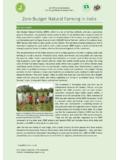Transcription of Rate Increase Needed for APD’s HCBS Waiver …
1 Florida ARF Talking Points APD ibudget Rate Increases December 4, 2017 Rate Increase Needed for APD s hcbs Waiver ( ibudget ) In July 2003, the State of Florida adopted the Mercer Rate system that established uniform rates for most of the 30+ Waiver services. The rate system was based on direct care wages funded at the 25th percentile compared to national averages for wages. Since July 2003, hcbs reimbursement rates have undergone multiple cuts for several rates such as Residential Habilitation, Adult Day Training, and Personal Support services. Reimbursement rates are on-average 11% lower than they were in 2003 while inflationary costs have increased 30%, meaning the rates are on average 41% lower than they should be considering today s dollars. Providers are experiencing hiring crises because they cannot pay competitive wages.
2 Consider The Florida Minimum Wage has increased from $ per hour in 2003 to $ per hour as of January 2018, a 60% Increase . Because staffing costs represent about 70% of provider agency operating expenses, ibudget Waiver providers are now facing hiring crises based on inadequate rates . The Consumer Price Index has increased by about 30% since 2003. Increased insurance costs for agencies such as employee health care, unemployment compensation, workers compensation, and property have increased significantly. Multiple unfunded mandates have been added in the form of additional billing requirements, background screening costs for staff, new licensure standards, staff training and experience requirements, and now additional privacy and community integration standards that go into effect because of federal changes to hcbs waivers.
3 Providers must have relief. Remaining on the current path will continue the deterioration of a network that has seen about a 30% drop in the number of providers providing services since FY 07-08, and a 39% reduction for agencies who were providing multiple (two or more) services. Staff turnover rates are at 40% on average because of low wages. A 3% rate reinstatement is required to bring the APD ibudget service system closer to 2003 levels for key services such as Residential Habilitation, Personal Supports, and Adult Day Training. Remedy Florida ARF requests $41 million ($ million in General Revenue) in recurring funds to cover the cost of the Department of Labor Home Care rule changes and to continue a very modest rate Increase for some select services that occurred last year via non-recurring dollars.
4 Florida ARF also requests a 3% Increase totaling $ million for select services rates to continue recent progress toward addressing competitive wages for direct care workers ($ million in General Revenue).




